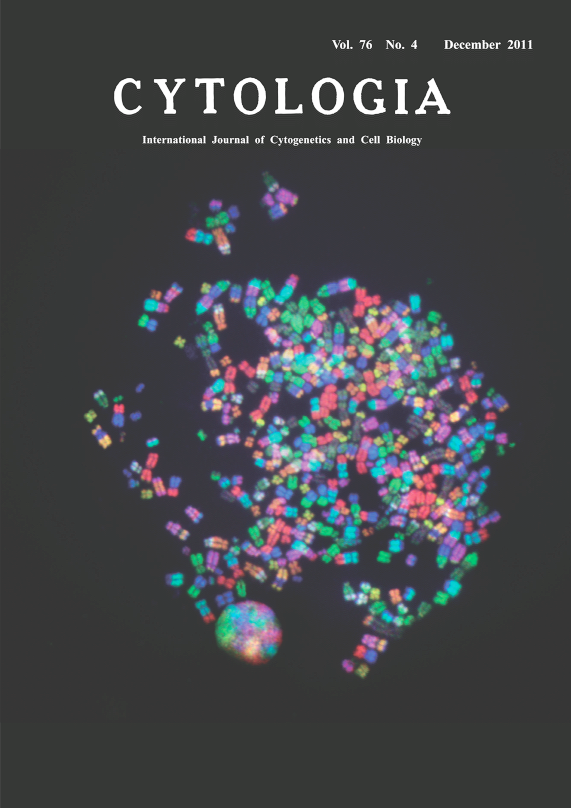| ON THE COVER |  |
|---|---|
| Vol. 76 No.4 December 2011 | |
| Technical note | |
|
|
|
| Multiplex Fluorescence In Situ Hybridization Visualizes a Wide Range of Numerical and Structural Chromosome
Changes Induced in Cultured Human Lymphocytes by Ionizing Radiation. Multiplex or multicolor fluorescence in situ hybridization (M-FISH) is a molecular cytogenetic technique that permits the simultaneous visualization of all human chromosomes (22 autosomal chromosomes and 2 sex chromosomes) in different colors. This technique facilitates definite karyotype analysis, enabling the unambiguous identification of complex chromosomal rearrangements. The applications of M-FISH for detecting chromosomal changes are manifold. We use this technique to analyze the induction and persistence of chromosomal aberrations in cultured human peripheral blood lymphocytes following gamma irradiation. The picture on the title page shows the metaphase spread observed in human lymphocytes exposed to 15-Gy gamma rays at a dose rate of 0.5 Gy/min and cultured for 96 h. M-FISH was performed using a commercially available multicolor probe kit (MetaSystems, Altlussheim, Germany) following the manufacturer’s protocol with modifications. In brief, chromosome preparations were denatured in an alkaline solution (0.07N NaOH) at room temperature for 1 min followed by dehydration in ethanol series. A total of 12 μL probe solution was denatured at 75°C for 5 min, incubated at 37°C for 30 min, dropped onto a slide to hybridize to denatured chromosomes, overlaid with a piece of coverslip and kept at 37°C for 2 days in the dark. Then, the slide was washed in a post-hybridization solution (0.4×SSC/0.1% Tween-20) for 2 min at 72°C, air-dried, and counterstained with 125 μg/ml 4′,6-diamidine-2-phenylindole (DAPI). Chromosomes were observed under a fluorescence microscope (Olympus BX-50, Tokyo, Japan) equipped with a CCD camera (Pursuit, Diagnostic Instruments, Inc., MI, USA) coupled with a filter-wheel set (Ludl Electronic Products, NY, USA). Metaphase images obtained from filter sets specific for fluorescein isothiocyanate (FITC), Cy3 and Cy5 were merged using image processing software (Diagnostic Instruments, Inc., MI, USA). As shown in the picture, the metaphase cell exhibits an octaploid chromosome constitution associated with many rearranged chromosomes that display various combinations of differentially colored chromosome segments. An interphasic nucleus is also seen in the lower left hand quadrant of this picture. M-FISH analysis revealed that after high-dose irradiation, there were cells that could proceed to the consecutive replication cycles, persisting with unstable aberrant chromosomes in the polyploidy state. Our current interest is focused on the persistence of radiation-induced unstable chromosome changes and its underlying mechanisms. (Yumiko Suto, Miho Akiyama, Nobuyuki Sugiura and Momoki Hirai, Department of Radiation Dosimetry, Research Center for Radiation Emergency Medicine, National Institute of Radiological Sciences, 4–9–1 Anagawa, Inage-ku, Chiba 263–8555, Japan.) |
|